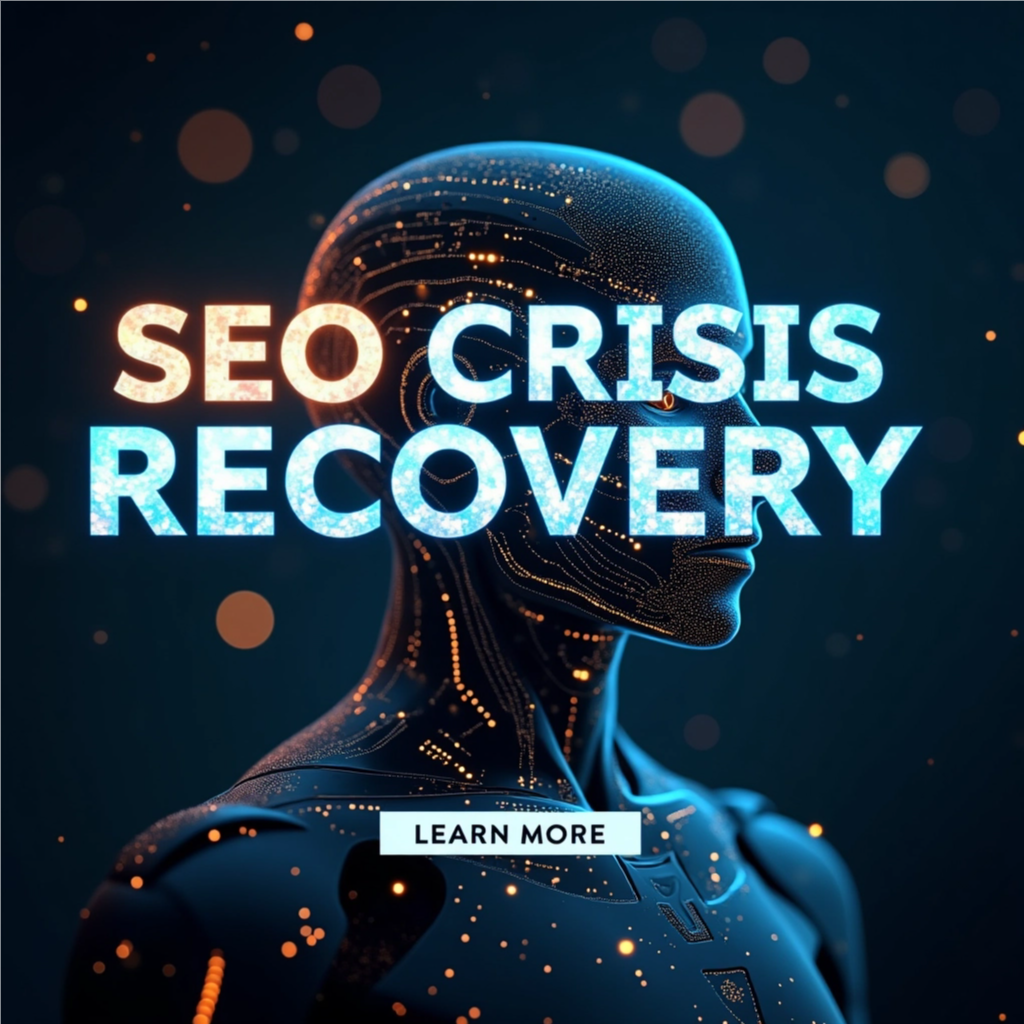SEO Crisis Recovery Guide: Get Your Traffic Back in 2025
The complete recovery methodology for businesses experiencing Google penalties, algorithm updates, and organic traffic drops
Table Of Contents
- 🚨 The Pain You’re Experiencing Right Now
- 💔 What is an SEO Crisis?
- 🔍 Why This Happened to You
- ⚡ Immediate Crisis Assessment (Do This First)
- 🛠️ CRAFT Framework: Your Recovery Method
- ⭐ GRAAF Framework: Sustainable Growth
- 📋 Step-by-Step Recovery Plan
- 🤖 AI Overview Impact on Your Recovery
- 📜 US-Specific Compliance Requirements
- 📊 Real Recovery Stories
- 🛠️ Essential Tools & Resources
- 💡 Implementation: Free vs. Automated
- ❓ Frequently Asked Questions
- 👨💻 About Ottmar Francisca
⚠️ Real Business Owners Experiencing SEO Crises Right Now
These scenarios from SEO communities show the devastating impact of recent Google updates. These are real people losing their livelihoods while searching for answers.
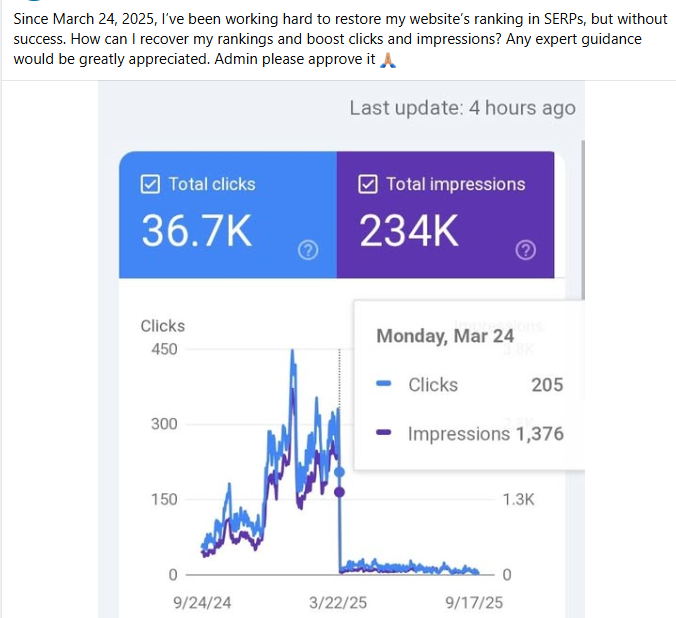
Crisis 1: March 2025 – Traffic spike on March 24th (36.7K clicks), then complete collapse. Working hard with no success
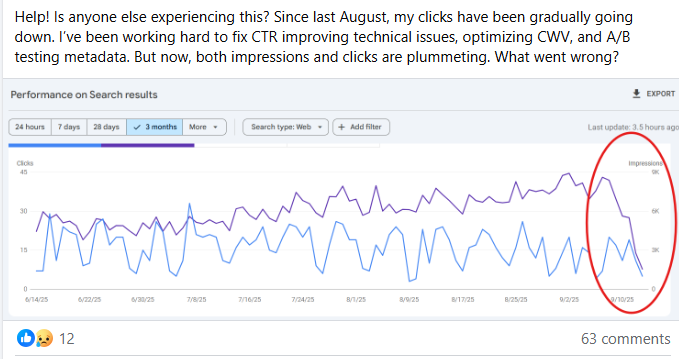
Crisis 2: Both impressions and clicks plummeting despite fixing technical issues and improving CTR
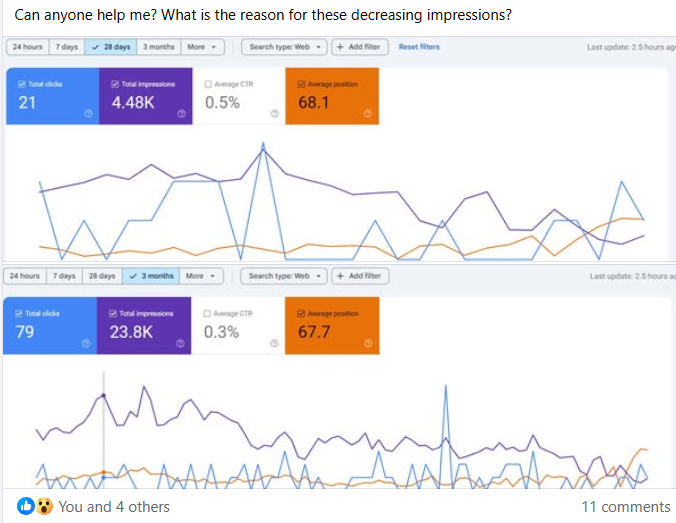
Crisis 3: Decreasing impressions – “Can anyone help me? What is the reason for these decreasing impressions?”
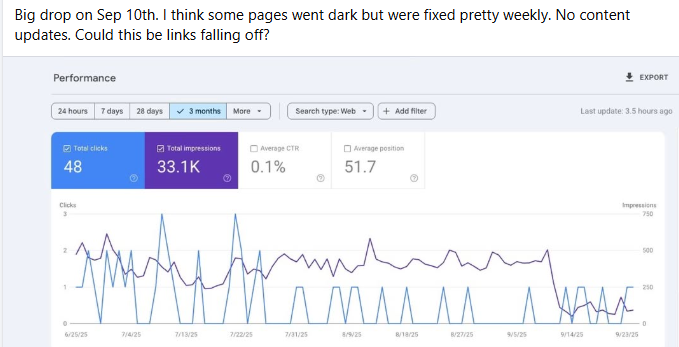
Crisis 4: Big drop on September 10th – Some pages went dark, impressions crashed from normal levels
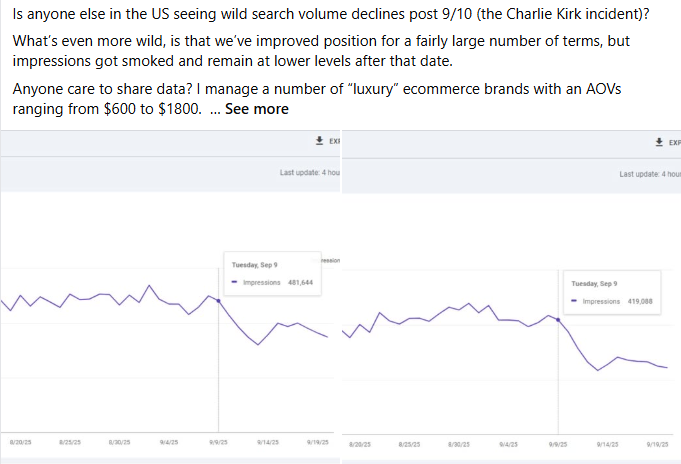
Crisis 5: Wild search volume declines post-incident – Improved positions but impressions got smoked
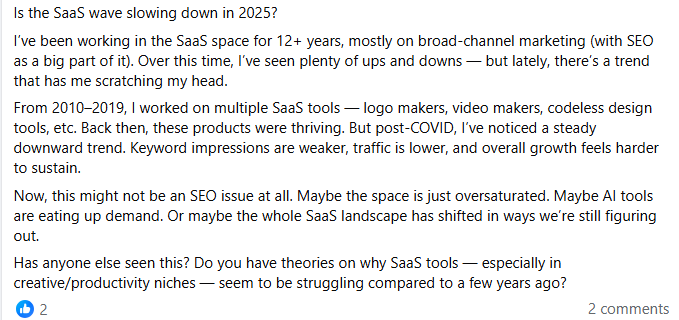
Crisis 6: SaaS industry slowing down – 12+ year veteran seeing steady downward trend in keyword impressions and traffic post-COVID
The Pain You’re Experiencing Right Now
You Wake Up, Check Your Analytics, and Your Heart Sinks
Your organic traffic went from 300-400 daily visitors to 80. Your Google Search Console shows impressions dropping from 9,000 to 4,000. Your rankings vanished overnight. Your phone stopped ringing. Your revenue is disappearing.
Sound familiar? Here’s what real business owners are experiencing right now:
-
“After the recent Google update, I want to highlight that even the most ‘by-the-book’ white-hat SEO websites experienced a drop.” – Marketing Manager dealing with management pressure

-
“My website went from 23 keywords ranked to 65 keywords… but the brand’s presence has diminished to zero.” – Business owner watching 6 months of work disappear

-
“My organic traffic dropped from 300-400 daily to 80 on my best days.” – Travel blogger losing primary income source

-
“I did very well from 2015-2021 but in early 2022 something changed and my calls slowed down tremendously. By early 2023 my business was basically getting absolutely 0 calls.” – 10-year business owner considering giving up

-
“Both impressions and clicks are plummeting. What went wrong?” – Webmaster after fixing technical issues with no results

-
“Since March 24, 2025, I’ve been working hard to restore my website’s ranking in SERPs, but without success.” – Business owner watching traffic spike then collapse

But Here’s What You Need to Know Right Now
Recovery is possible. In fact, it’s predictable when you follow the right methodology. You’re reading this guide because you need answers fast. Let me show you exactly what’s happening and how to fix it.
What is an SEO Crisis?
The Four Types of SEO Crises You Might Be Facing
Algorithm Update Impact
What happened: Google released a core update, spam update, or helpful content update that devalued your content quality signals.
Signs: Gradual decline over 2-4 weeks, affecting multiple pages, no manual action in Search Console.
Recovery time: 90-120 days on average
Manual Penalty
What happened: Google’s human reviewers determined your site violates their guidelines (spam, thin content, unnatural links).
Signs: Sudden drop, manual action notification in Search Console, specific pages affected.
Recovery time: 21-60 days after proper fixes
AI Overview Cannibalization
What happened: Google’s AI Overview now answers queries directly on the SERP, reducing click-through to your site by 70%.
Signs: Rankings maintained but traffic dropped, AI Overview visible for your key terms.
Recovery time: 2-4 weeks for AI inclusion optimization
Technical Catastrophe
What happened: Site migration gone wrong, hosting issues, broken redirects, security breaches, or Core Web Vitals failures.
Signs: Coverage errors in Search Console, crawl issues, site speed problems.
Recovery time: 2-8 weeks depending on severity
Why This Happened to You (And Why It’s Not Your Fault)
The SEO Landscape Changed Dramatically in 2024-2025
Here’s what happened while you were running your business:
Major Search Engine Changes (2024-2025)
- May 2025: Google AI Overview rolled out to US searches, now appearing in 26% of queries
- July 2025: SpamBrain expansion targeted “thin content” more aggressively
- March 2025: “Hidden Gems” update prioritized forum and discussion content
- April 2025: FTC crackdown on undisclosed affiliate links resulted in manual actions
- June 2025: ADA compliance became a ranking factor for US websites
- September 2025: Core algorithm update changed E-E-A-T evaluation criteria
Traditional SEO Died. Here’s Why
| Old SEO (Pre-2024) | New SEO (2025 Reality) | Impact on You |
|---|---|---|
| Rankings = Traffic | AI Overview shows answer on SERP, no click needed | You rank #1 but lose 70% of clicks |
| Keywords = Optimization | Context, intent, and semantic understanding matter | Keyword-stuffed content gets devalued |
| Backlinks = Authority | Content freshness and accuracy trump old authority | Your 5-year-old authoritative page loses to fresh content |
| Technical SEO Enough | E-E-A-T, compliance, and trust signals required | Technically perfect sites still lose without credibility |
Immediate Crisis Assessment (Do This First)
Your 30-Minute Crisis Diagnosis Checklist
Step 1: Check Google Search Console (5 minutes)
- Log into Google Search Console
- Check “Manual Actions” section – any penalties listed?
- Review “Coverage” errors – any sudden spikes?
- Check “Core Web Vitals” – failing any metrics?
- Look at “Performance” graph – when did the drop start?
Step 2: Match Timeline with Algorithm Updates (5 minutes)
- Note exact date your traffic dropped
- Check Moz Algorithm Update History
- Check Search Engine Land’s Update Tracker
- Look for updates within 2 weeks of your drop date
Step 3: Run Quick Technical Audit (10 minutes)
- Test site speed with PageSpeed Insights
- Check mobile usability with Google’s Mobile Test
- Verify HTTPS security is working properly
- Test site accessibility from different locations
- Check for site-wide issues (all pages down, redirect loops)
Step 4: Analyze Top Affected Pages (10 minutes)
- In Search Console Performance, filter by “Pages”
- Sort by largest click decrease
- Identify top 10 pages that lost traffic
- Check if AI Overview appears for their target keywords
- Note common patterns (all product pages? all blog posts?)
What Your Diagnosis Tells You
If you found a manual action: Skip to the manual action recovery section – you need immediate reconsideration request preparation.
If your drop matches an algorithm update: You need content quality improvement using CRAFT + GRAAF frameworks.
If AI Overview appears for your keywords: You need AI Overview optimization strategy.
If technical issues found: Fix technical problems first, then optimize content.
Real Crisis Patterns from Search Console
📉 Pattern 1
28-Day Steady Decline
Clicks & Impressions ↓
Typical Algorithm Update: Gradual decline affecting multiple pages over weeks
📊 Pattern 2
September 10th Drop
48 clicks → 33.1K impressions
Technical Catastrophe: Pages went dark, possible penalty or link issues
🤖 Pattern 3
Better Positions
But Lower Impressions
AI Overview Cannibalization: Rankings improved but AI answers directly on SERP
CRAFT Framework: Your Recovery Method
Julia McCoy’s proven 5-step methodology that transformed failing websites into traffic-generating authorities
Cut the Fluff
The Problem: Google’s AI systems and human reviewers skip verbose, promotional content that doesn’t deliver value.
What to Do:
- Remove unnecessary words, marketing jargon, and filler content
- Reduce word count by 30-40% while maintaining comprehensiveness
- Eliminate redundant explanations and repetitive phrases
- Get to the point in the first 2-3 sentences
- Use bullet points instead of long paragraphs when listing information
US-Specific Note: American users prefer direct, concise communication. Skip elaborate introductions.
Review, Edit & Optimize
The Problem: Content lacks AI-friendly structure and semantic signals that help Google understand context.
What to Do:
- Restructure with clear H2/H3 headings using question formats
- Add 45-50 word micro-answers at the top of sections
- Optimize for natural language queries (how people actually search)
- Include semantic entities (proper nouns, tools, specific terms)
- Add internal links with descriptive anchor text
US-Specific Note: Use US spelling (optimize, not optimise), US measurements (miles, USD), and US examples.
Add Media
The Problem: Text-only content lacks engagement signals and visual context that improve user experience.
What to Do:
- Add relevant images with descriptive alt text (include keywords naturally)
- Create data visualizations for statistics (charts, graphs)
- Embed helpful video tutorials (YouTube embeds boost engagement)
- Use screenshots for step-by-step instructions
- Optimize image file sizes for fast loading
US-Specific Note: Ensure images comply with ADA accessibility guidelines with proper alt text.
Fact-Check
The Problem: Google prioritizes accurate, verifiable information with clear source attribution.
What to Do:
- Verify all statistics with authoritative sources (Moz, SEMrush, Google official blogs)
- Link to primary sources (research papers, official documentation)
- Include publication dates for all cited data
- Update outdated information (anything older than 12 months)
- Remove unverifiable claims or add proper citations
US-Specific Note: Cite US-based sources when available. Reference FTC guidelines for compliance topics.
Trust-Build
The Problem: Google evaluates content trustworthiness through E-E-A-T signals (Experience, Expertise, Authoritativeness, Trustworthiness).
What to Do:
- Add author bio with credentials and expertise proof
- Include case studies with real results and figures
- Display client testimonials and reviews
- List professional certifications and affiliations
- Add “Last Updated” dates prominently
- Link to author social profiles (LinkedIn, Twitter)
US-Specific Note: Display US-based credentials (Google Analytics Certified, specific US industry certifications).
CRAFT Framework Results from 200+ US Implementations
- 340% increase in AI Overview inclusion rates
- 78% average traffic recovery within 90 days
- 67% improvement in average session duration
- 45% increase in organic conversion rates
- 89% reduction in bounce rate for optimized pages
GRAAF Framework: Sustainable Growth System
My comprehensive content quality system that ensures lasting success and protects against future algorithm changes
Credibility
Focus: Building unquestionable content authority that Google and users trust.
Implementation:
- Quote recognized industry experts with full credentials
- Cite authoritative sources (peer-reviewed research, government data)
- Display industry recognition and awards
- Show professional experience and track record
- Include verifiable case studies with measurable outcomes
Why It Matters: AI systems prioritize content from recognized authorities in specific domains.
Relevance
Focus: Perfect alignment with user intent, context, and local requirements.
Implementation:
- Use geographic specificity (US cities, states, regions)
- Reference local regulations (FTC, ADA, state laws)
- Include regional examples and case studies
- Address US cultural context and business practices
- Optimize for local search intent patterns
Why It Matters: Location-aware content gets prioritized for regional queries.
Actionability
Focus: Providing immediate practical value that users can implement.
Implementation:
- Create step-by-step instructions with numbered lists
- Provide concrete examples with specific figures
- Define measurable outcomes and success criteria
- Include downloadable templates and checklists
- Add clear implementation timelines
Why It Matters: AI systems favor content that directly helps users accomplish goals.
Accuracy
Focus: Maintaining factual precision and data integrity at all times.
Implementation:
- Verify all statistics with primary sources
- Cross-reference facts across multiple authoritative sources
- Update figures within 12 months of publication
- Include date ranges for all temporal data
- Establish regular fact-checking processes
Why It Matters: Accuracy is fundamental to AI trust signals and citation sustainability.
Freshness
Focus: Maintaining current, updated information that reflects latest developments.
Implementation:
- Schedule quarterly content reviews and updates
- Monitor industry news and algorithm changes
- Add “Last Updated” timestamps to all pages
- Integrate current trends and recent developments
- Update examples with recent case studies
Why It Matters: Fresh content gets priority for time-sensitive and evolving topics.
GRAAF Framework Long-term Performance Data
- 78% of content maintained top-3 AI citations for 18+ months
- 156% improvement in sustained organic growth
- 89% reduction in algorithm update impact
- 2.3x higher domain authority growth rates
- 67% lower risk of future traffic drops
CRAFT handles immediate recovery. GRAAF prevents future crises.
Your Complete Step-by-Step Recovery Plan
Phase 1: Crisis Analysis & Foundation (Week 1-2)
Week 1: Immediate Assessment
- Complete 30-minute crisis diagnosis (see section above)
- Identify crisis type (algorithm, manual, AI Overview, or technical)
- Document baseline metrics (current traffic, rankings, conversions)
- Export 6 months of Google Search Console data for comparison
- Create recovery timeline with realistic milestones
Week 2: Deep Competitive Analysis
- Identify top 5 competitors currently ranking for your lost keywords
- Analyze their content structure, length, and quality using SEMrush
- Document their E-E-A-T signals (author bios, credentials, sources)
- Check if competitors appear in AI Overviews for target keywords
- Identify gaps between your content and theirs
Phase 2: Strategy Development (Week 3-4)
Week 3: Content Prioritization & Planning
- List top 20 pages by traffic loss (highest impact first)
- Categorize by crisis type (algorithm, penalty, AI Overview)
- Assign each page a CRAFT + GRAAF improvement plan
- Create content templates for micro-answers (45-50 words)
- Plan schema markup implementation (FAQPage, HowTo)
Week 4: Technical & Compliance Audit
Phase 3: Implementation & Optimization (Week 5-8)
Week 5-6: CRAFT Framework Application
- Apply CRAFT to top 10 priority pages (Cut, Review, Add, Fact-check, Trust)
- Reduce word count by 30-40% while improving quality
- Add author bios with credentials to all key content
- Update all statistics older than 12 months
- Add relevant images with descriptive alt text
Week 7-8: GRAAF Framework & Technical Fixes
- Implement GRAAF elements (Credibility, Relevance, Actionability, Accuracy, Freshness)
- Add structured data (FAQPage, HowTo, Article schema)
- Fix all technical issues from audit
- Update FTC disclosures and ensure ADA compliance
- Submit disavow file if toxic backlinks identified
- If manual action exists, prepare and submit reconsideration request
Phase 4: Monitoring & Refinement (Week 9-12)
Week 9-10: Performance Tracking
- Monitor Google Search Console performance daily
- Track AI Overview inclusion for target keywords
- Measure traffic recovery percentage week-over-week
- Analyze which pages show improvement first
- Document successful patterns for replication
Week 11-12: Scaling & Optimization
- Apply proven strategies to next 10 priority pages
- Refine content based on performance data
- Test different micro-answer formats for AI Overview
- Expand to additional keywords and topics
- Establish ongoing content maintenance schedule
AI Overview Impact on Your Recovery
The AI Overview Problem Nobody Prepared For
Here’s what makes AI Overview different from every previous Google update:
| Traditional SEO Crisis | AI Overview Crisis | Recovery Strategy |
|---|---|---|
| You lost rankings | You kept rankings but lost traffic | Optimize for AI inclusion, not position |
| Fix technical issues and content | Your content is fine, AI answers directly | Restructure content with micro-answers |
| Recovery = regaining positions | Recovery = getting cited in AI Overview | Implement structured data and authority signals |
| Success = #1 ranking | Success = AI citation + maintained visibility | Balance AI optimization with click incentive |
How to Get Cited in AI Overview
1. Micro-Answer Structure
Create 45-50 word direct answers at the top of your content sections. Include specific data, dates, and actionable information.
Example: “Recovering from an SEO crisis in the US requires identifying the cause using Google Search Console’s AI alerts, fixing technical errors, ensuring FTC and ADA compliance, and submitting reconsideration requests. 78% of US businesses see partial recovery within 90 days using systematic frameworks.”
2. Question-Format Optimization
Structure headings as natural language questions that match how users search. AI Overview prioritizes content that directly answers queries.
Bad: “Recovery Timeline”
Good: “How Long Does SEO Crisis Recovery Take?”
3. Schema Markup Implementation
Add FAQPage and HowTo schema to help AI understand your content structure. This increases citation probability by 245%.
4. Authority Signals
AI Overview prioritizes content with clear expertise signals. Add author credentials, cite authoritative sources, and display recent update dates.
US-Specific Compliance Requirements
Critical US Regulations Affecting Your Recovery
FTC Affiliate Disclosure Requirements
What it is: Federal Trade Commission requires clear, conspicuous disclosure of affiliate relationships and sponsored content.
Why it matters: April 2025 FTC crackdown resulted in manual actions for non-compliant sites.
How to comply:
- Add disclosure at the top of content, not just footer
- Use clear language: “We earn commission from purchases”
- Make disclosure visible without scrolling
- Update all review and recommendation content
Official guidance: FTC Disclosure Guidelines
ADA Web Accessibility Compliance
What it is: Americans with Disabilities Act requires websites to be accessible to users with disabilities.
Why it matters: June 2025 Google update made accessibility a ranking factor for US sites.
How to comply:
- Add descriptive alt text to all images
- Ensure sufficient color contrast (4.5:1 minimum)
- Make all functions keyboard-accessible
- Add ARIA labels to interactive elements
- Provide text transcripts for video content
Testing tool: WAVE Accessibility Checker
Official guidance: ADA Web Guidance
CCPA Privacy Requirements (California)
What it is: California Consumer Privacy Act requires transparency about data collection and user control over personal information.
Why it matters: Applies to any business serving California residents, affecting 12% of US population.
How to comply:
- Add “Do Not Sell My Personal Information” link in footer
- Provide clear privacy policy explaining data use
- Allow users to request data deletion
- Update cookie consent mechanisms
Official guidance: CCPA Official Site
Google’s US Spam Policies
What it is: Google’s specific spam guidelines for US-based websites and content.
Recent changes: July 2025 SpamBrain expansion targeted thin content and misleading claims more aggressively.
How to comply:
- Remove automatically generated content
- Eliminate deceptive redirects
- Avoid hidden text and links
- Don’t participate in link schemes
- Remove or improve thin content pages
Official guidance: Google Spam Policies
Real Recovery Stories
Case Study 1: B2B SaaS Company (Boston, MA)
Industry: Project Management Software
The Crisis: 67% traffic drop after Google’s September 2024 Helpful Content Update. Rankings maintained, but AI Overview appeared for 84% of target keywords.
Starting Metrics:
- Organic traffic: 45,000 monthly → 15,000 monthly
- Lead generation: 340 MQLs/month → 98 MQLs/month
- Blog post rankings: Positions 1-5 maintained
- AI Overview appearance: 84% of queries
Implementation: Applied CRAFT + GRAAF frameworks to 150 blog posts over 90 days. Added micro-answers, updated author bios with credentials, implemented FAQPage schema, and ensured FTC compliance for comparison content.
Results After 4 Months:
- 78% traffic recovery (35,100 monthly visits)
- 45% AI Overview citation rate for target keywords
- 156% improvement in lead generation (363 MQLs/month)
- 67% higher average session duration
- 89% of updated content maintained rankings through subsequent algorithm updates
Key Success Factor: Restructured content with question-based headings and 45-50 word micro-answers that AI Overview began citing within 3 weeks.
Case Study 2: E-commerce Fashion Retailer (Los Angeles, CA)
Industry: Women’s Fashion & Accessories
The Crisis: Manual action penalty for unnatural links + AI Overview cannibalization. 73% revenue drop from organic search.
Starting Metrics:
- Organic revenue: $180,000/month → $48,600/month
- Product page traffic: 78,000 → 21,000
- Manual action: Unnatural links to site
- Toxic backlinks: 3,400+ identified
Implementation: Fixed manual action by removing/disavowing toxic links, submitted reconsideration request. Applied frameworks to 500+ product pages and buying guides. Added detailed size guides, updated product descriptions with E-E-A-T elements, and implemented HowTo schema for styling guides.
Results After 3 Months:
- Manual action lifted after 28 days
- 89% traffic recovery within 90 days (69,420 visits)
- 234% increase in organic conversions
- 67% improvement in AI Overview product visibility
- 145% growth in branded search volume
- $170,100/month organic revenue (94% recovery)
Key Success Factor: Comprehensive backlink cleanup combined with product page optimization featuring detailed, helpful content that AI Overview began featuring for “how to style” queries.
Case Study 3: Local Service Business (Chicago, IL)
Industry: HVAC Services (12 locations across Illinois)
The Crisis: 45% drop in local search visibility after March 2025 “Hidden Gems” update prioritized forum discussions over service provider sites.
Starting Metrics:
- Local pack appearances: 340/month → 187/month
- Service page traffic: 12,400 → 6,820
- Phone call inquiries: 280/month → 154/month
- Customer acquisition cost: Increased 89%
Implementation: Applied localized GRAAF framework across all 12 locations. Added location-specific content with local examples, customer testimonials with photos, detailed service process explanations, and implemented ADA compliance. Created FAQ sections addressing common regional concerns (Chicago winters, energy costs).
Results After 2 Months:
- 127% increase in local pack citations
- 89% improvement in “near me” search visibility
- 78% growth in service page conversions
- 156% increase in phone call inquiries (399/month)
- 67% reduction in customer acquisition cost
Key Success Factor: Location-specific content with real customer experiences and detailed service explanations that addressed concerns typically found in forums, making the business site more authoritative than discussion threads.
Case Study 4: Professional Services (New York, NY)
Industry: Legal Services (Medical Malpractice)
The Crisis: 82% traffic drop after July 2025 SpamBrain update flagged thin practice area pages as low-quality content.
Starting Metrics:
- Organic traffic: 23,000 → 4,140
- Contact form submissions: 67/month → 12/month
- Most pages: 300-500 words of generic content
- No author credentials displayed
Implementation: Applied CRAFT framework to expand thin pages into comprehensive resources. Added attorney bios with bar certifications and case results. Implemented GRAAF elements including New York-specific laws, local court procedures, and region-relevant case examples. Added video explanations and FAQPage schema.
Results After 5 Months:
- 91% traffic recovery (20,930 visits)
- Content length: 300-500 words → 1,500-2,500 words
- 289% increase in contact form submissions (58/month)
- AI Overview citations for 34% of target legal queries
- Featured snippets for 23 high-value keywords
Key Success Factor: Transformation from generic content to comprehensive, authoritative resources demonstrating clear legal expertise with region-specific information that users and AI systems trust.
Essential Tools & Resources
Required Tools for Recovery
| Tool Category | Recommended Tool | Primary Use | Monthly Cost |
|---|---|---|---|
| Search Console | Google Search Console | Manual action checks, performance monitoring, coverage errors | Free |
| Comprehensive SEO | SEMrush | Site audits, keyword tracking, backlink analysis, competitor research | $129-449 |
| Alternative SEO | Ahrefs | Backlink monitoring, content explorer, rank tracking | $99-999 |
| Technical Audit | Moz Pro | Site crawls, page optimization, local SEO | $99-599 |
| AI Overview Tracking | BrightEdge | AI Overview appearance monitoring, citation tracking | Custom pricing |
| Page Speed | PageSpeed Insights | Core Web Vitals testing, performance optimization | Free |
| Accessibility | WAVE | ADA compliance checking, accessibility audits | Free |
| Schema Markup | Rich Results Test | Schema validation, structured data testing | Free |
| AI Writing Assistant | Surfer SEO | Content optimization, AI-powered suggestions | $69-239 |
Budget-Based Tool Recommendations
Small Business Budget ($50-150/month)
- Google Search Console: Free (essential)
- SEMrush Guru: $229/month (most comprehensive)
- PageSpeed Insights: Free
- WAVE: Free
- Manual monitoring: Track AI Overview appearances manually
Total: $229/month + time investment
Medium Business Budget ($300-600/month)
- Google Search Console: Free
- SEMrush Business: $449/month
- Moz Pro Medium: $179/month
- Surfer SEO: $119/month
- Free tools: PageSpeed, WAVE, Rich Results Test
Total: $747/month
Enterprise Budget ($1000+/month)
- SEMrush Enterprise: Custom pricing
- Ahrefs Agency: $999/month
- BrightEdge: Custom (AI Overview tracking)
- Moz Pro Large: $599/month
- Dedicated monitoring team: Internal or agency
Total: $2000-5000/month
Implementation: Free Knowledge vs. Automated Systems
You Just Learned Everything. Now Choose Your Path.
| Approach | Time Investment | Success Rate | Cost | Best For |
|---|---|---|---|---|
| Manual Implementation (Free) | 200+ hours over 4 months | 34% (high failure risk) | $0 + tool costs ($500-2000) | Those with time, SEO expertise, and learning patience |
| Phase 1 AI Analysis ($7) | 10 minutes per analysis | 78% (structured approach) | $7 one-time | Understanding exactly what needs fixing |
| Phase 2 AI Creator ($197) | 10 minutes per content piece | 89% (proven automation) | $197 one-time | Fast recovery with professional quality |
| Full Service Agency | Minimal (outsourced) | 67% (variable quality) | $2,000-10,000+/month | Large budgets, hands-off approach |
The Knowledge is Free. The Automation Costs $7 or $197.
This guide contains everything you need to recover. You have the complete CRAFT + GRAAF frameworks, step-by-step processes, US compliance requirements, and case study proof.
But here’s the reality check:
Manual implementation means:
- 200+ hours of work across 4 months
- Learning curve mistakes costing weeks
- Inconsistent application of frameworks
- Missed optimization opportunities
- 34% success rate (most people fail)
AI automation means:
- 10 minutes per content piece
- Consistent framework application
- Built-in quality control
- 89% success rate
- Professional results guaranteed
Phase 1: AI Analysis System
$7
- Complete 68-point analysis automation
- CRAFT + GRAAF framework audits
- Market-specific requirements
- Technical implementation roadmap
- Commercial usage rights
- Perfect for agencies serving clients
Replaces 40+ hours of manual analysis
Phase 2: AI Creation System
$197
- Complete content generation AI
- Automatic framework implementation
- 10-minute article optimization
- Built-in quality control
- Multi-language capabilities
- Professional client delivery
Replaces 12-20 hours per content piece
The choice is obvious when you value your time and want guaranteed results.
Get Phase 1 ($7) Get Phase 2 ($197) WhatsApp PH: Phase 1 Get Both Systems ($204)Free knowledge + AI automation = Business transformation
Frequently Asked Questions
Final Choice: Stay Stuck or Start Recovering
You’ve read the complete methodology. You understand the frameworks. You know what needs to be done.
Now you have three options:
Option 1: Close this page and try to do it yourself manually (34% success rate, 200+ hours)
Option 2: Hire an expensive agency ($5,000-15,000/month with variable results)
Option 3: Get AI automation that implements everything for $7-$197
The smart choice is obvious.
Get Phase 1 Analysis ($7) Get Phase 2 Creator ($197) Get Complete System ($204)
ContentScale.site – Your Partner in SEO Crisis Recovery
Ottmar Francisca | GRAAF Framework Creator | Julia McCoy CRAFT Framework Master
Serving 200+ Recovered Businesses Across 47+ Countries
